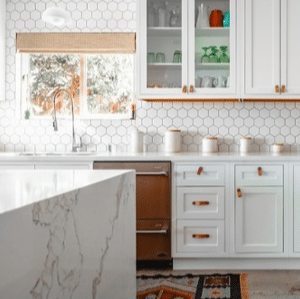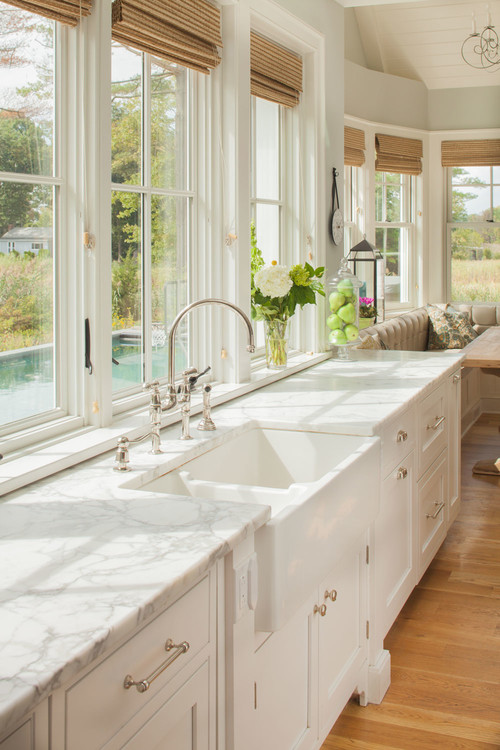Vermont Danby Marble vs. Carrara and Calacatta Marble

The trick, of course, is choosing the right marble for your practical needs and aesthetic preferences, and there are several varieties to choose from. Vermont Danby, Carrara, and Calacatta marbles are all stunning examples of white backgrounds with gray veining that are sought after by homeowners and professionals alike. While they may seem fairly similar on the surface, they have distinct characteristics that could cause you to prefer one over the other. So, how can you select the best variety for your home? Here’s what you need to know about Vermont Danby marble, Carrara marble and Calacatta marble.
Characteristics of Vermont Danby Marble
From the get-go, this marble sets itself apart from the other two marble surfaces because it is quarried in your own backyard. As the name suggests, Danby marbles come from Vermont, rather than Italy, which could mean a better price for a slab that is very similar in appearance to some of the most sought-after Italian marbles.
The island countertop in this contemporary New York kitchen gives you some idea of what you’ll enjoy when you choose Vermont Danby marble. A prime example, this slab features a bright, white background with light gray veining feathered throughout for a soft, refined appearance. When paired with dark cabinetry, the marble really pops, becoming the focal point of the kitchen, especially with chandelier lighting above and surrounding countertop surfaces in dark stone with white cabinets.
Vermont Danby is well known for hints of gold that lend a bit of warmth to what could be an otherwise predominantly cool neutral. Depending on the slab, it could lean closer to the coolness of Carrara or the warmth of Calacatta Gold.
Another reason to love this particular variety of marble is that it tends to be a bit denser than its Italian counterparts. It can still stain and etch, like any marble, so you’ll definitely want to seal it and care for it properly, but it could provide slightly better resiliency than other types of marble.
Characteristics of Carrara Marble
Carrara marble, so named because it comes from the city of Carrara, Tuscany in northern Italy, this is one of the most popular luxury stones in the world. It tends to be cool and cloud-like in appearance and is frequently more gray than white, with wispy, gray striations, as evidenced by the countertop in this traditional bathroom. Carrara marble is often paired with bright, white cabinetry, as in this example, to best showcase the subtlety of the stone.
Interestingly, you can directly compare Carrara to Calacatta here, as the latter is also featured in the flooring and shower (along with Venato marble). As you can see, Calacatta (which is also quarried in the Carrara region of Italy) has a whiter background with heavier gray striations. If you’re choosing between these two marbles, you’ll simply have to decide whether you prefer the boldness and drama of Calacatta or the more subtle patterning of Carrara.
Characteristics of Calacatta Marble
As noted above, traditional Calacatta marble is heavy on the veining, but the Calacatta Gold variety is a bit closer to the characteristics of Vermont Danby marble, with a lighter gray veining and gold highlights that warm up the stone for a slightly more traditional ambiance. This beachy New York kitchen is a prime example, featuring a crisp, white background with pale, but distinctive gray veining and a slightly warmer appearance.
White cabinets and warm, wood flooring come together nicely with the aid of this versatile marble, which neatly ties the whole design together and creates a bright and welcoming interior space. The honed finish used in the countertops helps to ease the transition between the bright whites of the interior and the beachy tones of the surrounding landscape, on prominent display via a large bank of windows that spans the length of this large, eat-in kitchen.
Read “Honed vs. Polished Marble: What’s the Difference?” here
Which is Right for You?
Choosing between Vermont Danby, Carrara, and Calacatta marble varieties can be understandably difficult. They’re all stunning in appearance, with similar characteristics. However, they do have subtle distinctions that set them apart from one another, not only in terms of appearance, but also density and of course, cost.
If you’re looking for a lot of personality from your stone, Calacatta will deliver the statement style you seek, and you can always tone it down and add a hint of warmth with a variety like Calacatta Gold.
If you’re searching for a cooler, gray tone with minimal veining, Carrara might be more your speed.
Or, if you prefer a happy medium that’s made in the USA, so to speak, you stand to gain significant benefits by selecting Vermont Danby marble. You’ll simply have to compare these white/gray marbles to decide which one is the perfect fit for your home.
Need help with your next project?
We would love to help you pick the perfect countertop material for your next kitchen upgrade or addition. To request a complimentary consultation with one of our design experts, click here.





